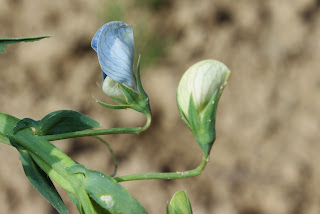
 Lathyrus sativus is a legume (family Fabaceae) commonly grown for human consumption and livestock feed in Asia and East Africa. It is a particularly important crop in areas that are prone to drought and famine, and is thought of as an 'insurance crop' as it produces reliable yields when all other crops fail. The seeds contain a neurotoxin that causes a neurodegenerative disease when the seeds are consumed as a primary protein source for a prolonged period.
Lathyrus sativus is a legume (family Fabaceae) commonly grown for human consumption and livestock feed in Asia and East Africa. It is a particularly important crop in areas that are prone to drought and famine, and is thought of as an 'insurance crop' as it produces reliable yields when all other crops fail. The seeds contain a neurotoxin that causes a neurodegenerative disease when the seeds are consumed as a primary protein source for a prolonged period.

 It is also known as grass pea, blue sweet pea, chickling pea, chickling vetch, Indian pea, white pea, white vetch, almorta or alverjón (Spain), guixa (Catalonia), jari grah (Croatia), λαθούρι (Greece), koçkulla (Albania), chícharos (Portugal), cicerchia (Italy), ሰበረ, sebere (Eritrea), ጓያ, guaya (Ethiopia), turmos (Arabic) and khesari (Bangladesh and India).
It is also known as grass pea, blue sweet pea, chickling pea, chickling vetch, Indian pea, white pea, white vetch, almorta or alverjón (Spain), guixa (Catalonia), jari grah (Croatia), λαθούρι (Greece), koçkulla (Albania), chícharos (Portugal), cicerchia (Italy), ሰበረ, sebere (Eritrea), ጓያ, guaya (Ethiopia), turmos (Arabic) and khesari (Bangladesh and India). Lathyrus sativus grows best where the average temperature ranges between 10–25°C and average rainfall is 400–650 mm per year. Like other legumes lathyrus sativus improves the nitrogen content of soil. The crop can survive drought or floods but grows best in moist soils. Lathyrus sativus tolerates a range of soil types from light sandy through loamy to heavy clay and acid, neutral or alkaline soils. Lathyrus sativus does not tolerate shade.
Lathyrus sativus grows best where the average temperature ranges between 10–25°C and average rainfall is 400–650 mm per year. Like other legumes lathyrus sativus improves the nitrogen content of soil. The crop can survive drought or floods but grows best in moist soils. Lathyrus sativus tolerates a range of soil types from light sandy through loamy to heavy clay and acid, neutral or alkaline soils. Lathyrus sativus does not tolerate shade. Seed is sold for human consumption at markets in Florence. Consumption of this pulse in Italy is limited to some areas in the middle part of the country, and is steadily declining[citation needed].
Seed is sold for human consumption at markets in Florence. Consumption of this pulse in Italy is limited to some areas in the middle part of the country, and is steadily declining[citation needed].Flour made from grass peas (Spanish: almorta) is the main ingredient for the gachas manchegas or gachas de almorta. Accompaniments for the dish vary throughout La Mancha. This is an ancient Manchego cuisine staple, generally consumed during the cold winter months. The dish is generally eaten directly out of the pan it was cooked in, using either a spoon or a simple slice of bread. This dish is commonly consumed immediately after removing it from the fire, being careful not to burn one's lips or tongue.
Grass pea flour is exceedingly difficult to obtain outside of Castilla-La Mancha, especially in its pure form. Commercially available almorta flour is mixed with wheat flour due to the fact that grass peas are toxic if consumed in significantly large quantities for prolonged periods of time.
Immature seeds can be eaten like green peas. Lathyrus sativus needs soaking and thorough cooking to reduce toxins.
Photos Kouklia Ammochostou 15/4/2016 by George Konstantinou


No comments:
Post a Comment